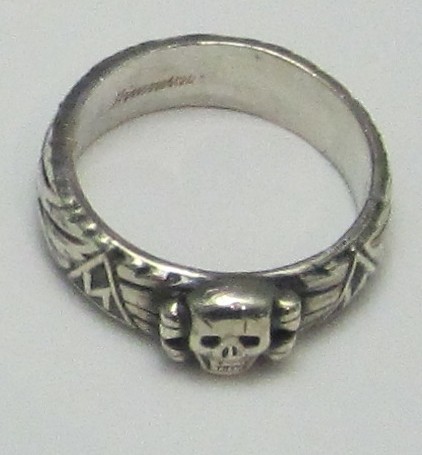Totenkopfring - The dead-head ring of the SS
- Dettagli
- Categoria: Spiritualità e Simbolismo - Spirituality and Symbolism
- Pubblicato Mercoledì, 31 Ottobre 2018 13:29
- Scritto da Super User
- Visite: 2342
Totenkopfring - The dead-head ring of the SS
SS-Ehrenring is the German name for the SS honor ring, also known as Totenkopfring or "dead-headed ring". It was not an official decoration of Nazi Germany, but rather an honor granted personally by the Reichsführer-SS Heinrich Himmler. The ring was designed by Karl Maria Wiligut, an Austrian writer and esoterist who had a significant influence on Nazi mysticism and Germanic neopaganism. It has been nicknamed the Rasputin of Himmler.
The ring appears for the first time as a personal tribute by Himmler to a small circle of collaborators on the occasion of Christmas 1933.
The runic design of the ring reflects Himmler's interest in Germanic mythology.
The head of the dead or Totenkopf was the traditional symbol of the SS, taken from other German and Prussian military units of the past, but also had a precise meaning at the SS, as Himmler himself was able to express in the letter that accompanied the ring : "The Totenkopf is to remember to be ready at any moment to give their life for the life of the whole organization."
The two runes representing two lightnings, are actually a variation of the Sig rune made by the SS and symbolize the victory, while the runes of Hagall represent faith and camaraderie.
The swastika was originally a symbol of light and hope. For the SS it was above all to signify the power of the Aryan race. The single Sig rune, which originally symbolized the power of the sun and the conquering energy, received, as already noted for the Sig rune, the new meaning of victory, which in German is written Sieg and pronounced "sig".
Slb was engraved on the inside of the ring. for Seinem Lieben (to our dear) followed by the sole surname of the assignee, by the date and a facsimile of Himmler's signature. The ring was delivered with a case on whose cover the double runes Sig of the SS were imprinted.
The ring was awarded on some specific dates and its conferment was also recorded in the recipient's personal cards.
With the circular 214/44 issued in October 1944, as a result of the scarcity of resources to which Germany was forced by the war effort, Himmler ordered the suspension until new date of production at the only authorized supplier: Otto und Karolina Gahr in Mariannenstrasse 3 of Munich.
Through the archives found at the offices of the SS in Berlin it was possible to ascertain a production of 14,752 rings in the period between 1936 and 1944 out of a total of about 20,000 specimens (taking into account the possible remakes due to an excessive attrition, loss, etc. etc.).
All the rings had to be sent back to the SS-Personalhauptamt on the death of the person to whom it was delivered, to be kept in Wewelsburg in order to keep the memory of the fallen alive. By January 1945, 64% of the 14,752 rings produced had been returned.
It has been hypothesized that about 3,500 rings have survived the war and this obviously makes them very rare. Needless to say, this decoration has been, and still is, falsified in all possible and imaginable ways.
- The TK-Rings were manufactured following roughly two major types, the one defined in the '30s and that of the' 40s. The ring models dating back to the '30s were thinner while the later ones were thickened to ensure greater resistance and durability over time.
- The skulls on the front of the ring are also different depending on the type. Those dating back to the '30s generally have a "drop" eye shape, while in the 1940s the ocular cavities are roundish.
- Usually on the inside of the ring, just behind the skull, is the junction line of the silver tape that makes up the base of the same.
- Even the shape of the nose differs according to the model: in the first it is more refined while in the second it is more "raw", sometimes also called "pig nose", that is "pig nose" because of its line.
- In the same way the panel of runes has undergone changes and changes in the course of the evolution of the two styles and we can roughly say that in the '30 model the runes usually have a wider shape than the '40 ones.
It should be remembered that during 1939 some rings were also made, few for the truth, which can be identified as "transitional". In fact, they often show characteristics that can be found in both the styles described above and sometimes unique characteristics.

